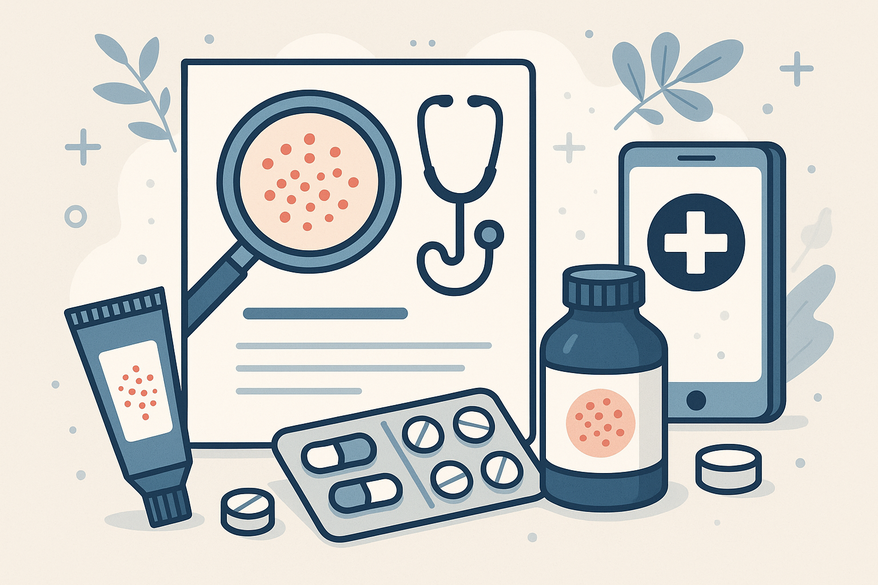Medication Rash Treatment: A Comprehensive Guide
Discover how to identify, diagnose, and manage medication-induced rashes effectively with our comprehensive guide on medication rash treatment.

Estimated reading time: 8 minutes
Key Takeaways
- Medication-induced rashes can vary in timing and appearance.
- Accurate diagnosis relies on thorough history and targeted testing.
- Treatment ranges from topical steroids to systemic immunomodulators.
- Prevention involves diligent medication reviews and allergy records.
Table of Contents
- Introduction
- 1. Understanding Medication-Induced Rashes
- 2. Identification and Diagnosis
- 3. In-Depth Look at Medication Rash Treatment
- 4. Managing and Preventing Medication-Induced Rashes
- 5. Follow-Up and Long-Term Considerations
- FAQ
Introduction
Medication-induced rashes are adverse skin reactions directly linked to prescription or over-the-counter drugs. Effective management not only relieves symptoms but also prevents complications and ensures safe ongoing medication use. In this guide, we cover how to recognize, diagnose, and treat these reactions while offering prevention and long-term care tips.
For a quick AI-powered assessment, upload clear photos to Rash Detector and get an instant sample report.

1. Understanding Medication-Induced Rashes
Definition
A medication-induced rash is a cutaneous reaction triggered by a drug, distinct from infections or contact allergens.
Timing and Appearance
- Timing: From hours to weeks after the first dose.
- Appearance:
- Hives: Raised, itchy welts that migrate.
- Maculopapular eruptions: Pink/red bumps, sometimes with peeling.
Common Causes and Risk Factors
- High-risk drugs: Antibiotics (penicillins, sulfa), anti-seizure medications, NSAIDs.
- Host factors: Genetic predisposition, allergy history, autoimmune conditions.
Key Symptoms to Watch For
- Itching, redness, or swelling—localized or widespread
- Hives merging into larger patches
- Blisters, peeling, pain
- Systemic signs: fever, breathing difficulty, facial swelling
2. Identification and Diagnosis
Recognizing Warning Signs
- New rash soon after starting a drug
- Rapid spread or severe itching
- Fever, facial swelling, or breathing trouble
When to Seek Professional Care
- Widespread rash covering large areas
- Severe discomfort interfering with daily life
- Systemic involvement: fever above 38°C, throat tightness
Diagnostic Methods
- Medical History Review – Document recent medications and past reactions.
- Physical Exam – Assess rash shape, color, and distribution.
- Allergy Testing – Skin prick or blood tests when the culprit isn’t clear.
- Skin Biopsy – Used for severe or unusual cases.
Expert Tip:
For more on identifying drug-induced symptoms.
3. In-Depth Look at Medication Rash Treatment
Core Principle
Discontinue the offending drug under medical supervision—never stop abruptly without guidance.
Mild to Moderate Treatments
- Topical Corticosteroids: 1% hydrocortisone cream twice daily.
- Oral Antihistamines: Diphenhydramine or non-sedating options like cetirizine and loratadine.
Severe or Extensive Reactions
- Oral Corticosteroids: Prednisone taper over 5–10 days.
- Intravenous Therapies: For rapid control in hospital settings.
- Epinephrine Auto-Injector: For anaphylaxis, followed by steroids and antihistamines.
- Immunomodulators: Methotrexate or cyclosporine for refractory cases.
Treatment protocols vary by rash type. Compare OTC vs prescription options.
4. Managing and Preventing Medication-Induced Rashes
Home Care Strategies
- Consult your provider before discontinuing any drug.
- Apply cool, damp compresses for 15–20 minutes.
- Use prescribed topical corticosteroids and antihistamines.
- Monitor red-flag symptoms: rapid spread, fever, breathing issues.
Prevention Tips
- Review all medications at each doctor visit.
- Request allergy testing after prior drug rashes.
- Keep an up-to-date allergy record; consider medical alert jewelry.
- Check for drug–drug interactions before starting new treatments.
5. Follow-Up and Long-Term Considerations
Follow-Up Appointments
- Confirm rash resolution and adjust therapy if needed.
- Use photos to track progress when recommended.
Lifestyle and Skin-Care Modifications
- Choose gentle, fragrance-free cleansers and moisturizers.
- Apply broad-spectrum sunscreen to exposed skin.
- Avoid harsh soaps, hot water, and excessive scratching.
Medication Substitution
- Collaborate with your healthcare team for safer alternatives.
- Document confirmed allergies in your medical record.
- Consult an allergist or immunologist for complex cases.
See also long-term safety strategies.
FAQ
- What causes a medication-induced rash?
- Drug rashes occur when the immune system reacts to a medication, often due to genetic factors or prior sensitization.
- How soon do drug rashes appear?
- They can develop within hours of the first dose or may take several weeks, depending on the drug and individual sensitivity.
- Can I treat a mild drug rash at home?
- Mild reactions often improve with topical corticosteroids, oral antihistamines, and cool compresses—always under a doctor’s supervision.
- When should I seek emergency care?
- If you experience rapid rash spread, high fever, breathing difficulty, or facial swelling, call emergency services immediately.





